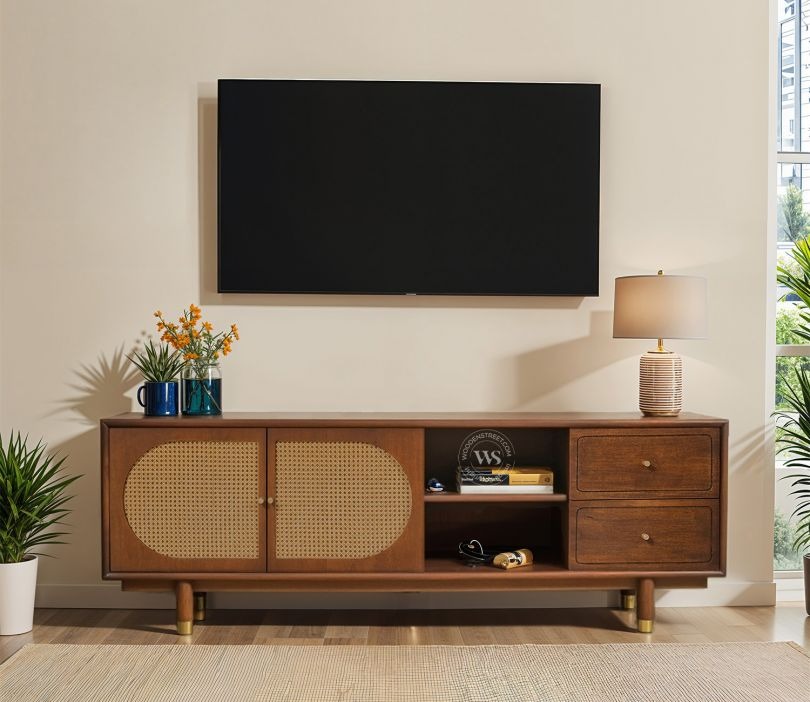When picking a TV unit, TV cabinet, TV stand, or wooden TV unit for your living room, it’s not just about looks. The right piece makes a big difference in comfort, visibility, storage, and how the room feels overall. Here’s how to make smart decisions that match your space and layout.
1. Measure Your Living Room & Screen First
Before anything else, a few measurements will save you from buying something that doesn’t fit or ruins the feel of the room:
- TV size: Include bezel/frame. Make sure the unit is slightly wider than the TV for balance.
- Available wall/floor space: How much width, height, depth do you have where the unit will go? Leave room on sides so it doesn’t feel cramped.
- Viewing distance & height: The center of the screen ideally should be at eye-level when sitting. Too high or too low strains neck. Also, how far your sofa is from the TV helps decide how large the TV should be, and thus how big the unit beneath or around it can be.
2. Match the TV Unit Style & Material to Your Layout
The layout of your living room and your decor style should guide the look of the unit:
- If your room is compact, lighter materials (wood tones, glass, minimalist metal) or open designs help keep the space airy. Bulky or heavy styles may overpower.
- For larger, more open living rooms, you can opt for more substantial wooden TV unit, or TV cabinets that include display shelves, closed storage, decorative elements.
- If your layout has unusual features (corners, alcoves, windows), consider corner TV units, wall-mounted units, or floating shelves to adapt.
3. Decide Type: Stand Alone, Cabinet, Wall-Mounted or Floating
Each form has pros and cons; choose based on layout, space, and usage.
| Type | Pros | Considerations |
|---|---|---|
| Freestanding TV stand / cabinet | Offers storage (closed & open), easier to move, style variety | Takes up floor space, depth matters, may crowd small rooms if large |
| Wall-mounted / Floating unit | Saves floor space, cleaner look, modern feel | Needs solid wall support, wiring must be planned, less closed storage unless cabinets are included |
| Corner units | Perfect for odd angles, uses space efficiently in non-rectangular rooms | Can be shallow in storage, viewing angles may be less ideal unless TV swivels or angle adjustments are possible |
| Built-in or custom units | Fit precisely to your layout, can integrate inside walls or alcoves, match décor | More expensive, takes more time, needs accurate measurement, less flexibility to change later |
4. Storage & Functionality Needs
A TV unit is not just for the TV. Think about what you will store or display, and how often you’ll access it.
- Open shelves allow easy access but need regular cleaning. Closed cabinets or drawers hide clutter. A mix often works well.
- Ensure space for all components: set-top boxes, gaming consoles, DVD/Blu-ray players, speaker systems, remotes. Also consider future needs.
- Cable management: Look for units with built-in holes, wire channels, or back-panels that keep wires hidden and safe.
5. Proportion: Size, Width, Height
How large or tall your TV unit is relative to the room and TV is critical for visual balance and comfort.
- Width: The unit should ideally be a little wider than the TV.
- Depth: Needs to accommodate the TV base plus any media components, without sticking out into walkways.
- Height: The ideal height puts the centre of the screen roughly at seated eye level. Usually a TV unit height of about 40–55 cm is suitable, depending on sofa height.
6. Match Layout Flow & Lighting
A well-planned layout avoids glare, improves comfort, and maintains room flow.
- Avoid placing the TV opposite large windows or bright light sources that will reflect on screen. If unavoidable, use curtains, blinds, or matte finishes.
- Maintain walkways: the unit should not block natural paths through the room. Leave space to walk around comfortably.
- Consider sightlines: In an open plan or irregular layout, people might view from various angles. A TV unit that allows tilting or swivel capability (or a wall bracket) might help.
7. Material, Finishes & Maintenance
What your TV unit is made of (and how it’s finished) affect durability, style, cost, and maintenance.
- Wood/solid wood: Warmth, classic appeal, good durability. Heavy and needs care to avoid moisture or scratches.
- Engineered wood / MDF / veneers: Often more affordable, many finish options. Less durable over time especially with heavy weight or moisture.
- Glass, metal, laminate: Modern aesthetic, sleek and lighter visually. Glass can break; metal may scratch; laminates may peel if poor quality.
- Colour/finish: Light tones visually open up space; darker tones add drama or warmth. Match or complement other furniture/floors/trim.

8. Budget, Quality & Long-Term Considerations
Set a budget but balance it with quality and what you’ll get long term.
- Cheaper TV stands may look good initially but may warp, sag, or lose finish over time. Investing in a better material, stable construction, and reliable hardware often pays off.
- If you expect to change rooms, move house, or upgrade your TV in future, choose a unit that has some flexibility (modular parts, neutral style).
- Warranty, after-sales service, availability of spare parts or hardware matters, especially for TV cabinet doors or drawers.
Conclusion
A TV unit or TV stand isn’t just a place to put your television it anchors your living room, complements your décor, impacts comfort, and influences how spacious or cluttered your room feels. By carefully measuring your space, choosing the right type, selecting finishes and storage options that suit your lifestyle, and keeping sightlines and layout in mind, you can choose a unit that looks great and feels just right.
When done well, your TV cabinet or wooden TV unit becomes both functional and stylish a centrepiece that enhances the living room without overwhelming it.


